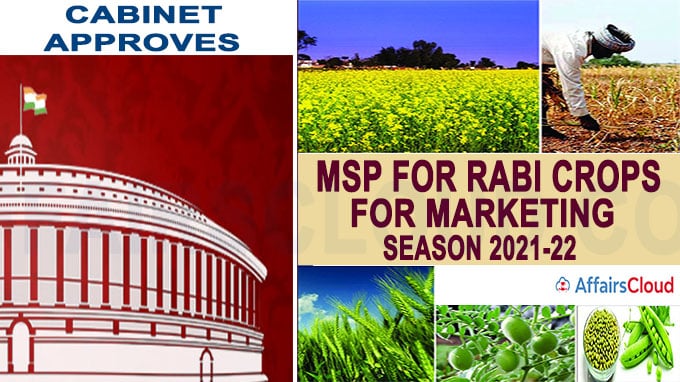 On the lines of the recommendations of Swaminathan Commission, on September 21, 2020, Cabinet Committee on Economic Affairs (CCEA) chaired by the Prime Minister Narendra Modi has approved an increase in the Minimum Support Prices (MSPs) for all mandated Rabi crops for marketing season 2021-22.
On the lines of the recommendations of Swaminathan Commission, on September 21, 2020, Cabinet Committee on Economic Affairs (CCEA) chaired by the Prime Minister Narendra Modi has approved an increase in the Minimum Support Prices (MSPs) for all mandated Rabi crops for marketing season 2021-22.
- The decision regarding the increase in MSPs for Rabi Marketing Season (RMS) 2021-22 is taken with the principle of fixing the MSPs at a level of at least 1.5 times of the All-India weighted average Cost of Production under “Pradhan Mantri AnnadataAaySanraksHan Abhiyan” (PM-AASHA) as announced in Union Budget 2018-19.
- This increase will also cater to the nutritional requirements and changing dietary pattern and to achieve self-sufficiency in pulses and oilseeds production.
Following table shows the MSP for RMS 2021-22 in comparison to RMS 2020-21
| Crops | MSP for RMS 2020-21 (Rs/quintal) | MSP for RMS 2021-22 (Rs/quintal) | Cost* of production 2021-22 (Rs/quintal) | Increase in MSP (Rs/quintal) | Return over cost (in per cent) |
|---|---|---|---|---|---|
| Wheat | 1925 | 1975 | 960 | 50 | 106 |
| Barley | 1525 | 1600 | 971 | 75 | 65 |
| Gram | 4875 | 5100 | 2866 | 225 | 78 |
| Lentil (Masur) | 4800 | 5100 | 2864 | 300 | 78 |
| Rapeseed & Mustard | 4425 | 4650 | 2415 | 225 | 93 |
| Safflower | 5215 | 5327 | 3551 | 112 | 50 |
Key Points:
–In this regard, the highest MSP has been announced for lentil (Rs. 300 per quintal) followed by gram and rapeseed & mustard (Rs. 225 per quintal each) and safflower (Rs. 112 per quintal).
–The expected returns to farmers over their cost of production are estimated to be highest in case of Wheat (106%) followed by rapeseed & mustard (93%), gram and lentil (78%). For barley, return to farmers over their cost of production is estimated at 65% and for safflower, it is 50%.
— In the case of cereals, Food Corporation of India (FCI) and other designated State Agencies will continue to provide price support to the farmers via procurement under PM-AASHA scheme. Domestic procurement of pulses is also being done under the Price Stabilization Fund (PSF).
- This procurement process is aiding the maximum number of farmers to get their benefit.
About PM-AASHA scheme:
The Umbrella Scheme “Pradhan Mantri AnnadataAaySanraksHan Abhiyan” (PM-AASHA) ensures remunerative prices to the farmers for their produce as announced in the Union Budget for 2018. It comprises three components viz. Price Support Scheme (PSS), Price Deficiency Payment Scheme (PDPS), and pilot Scheme of Private Procurement and Stockist Scheme (PPSS) will aid in procurement of pulses and oilseeds. These are explained as below:
Price Support Scheme (PSS): Under this, the physical procurement of pulses, oilseeds and Copra is done by the Central Nodal Agencies viz. National Agricultural Cooperative Marketing Federation of India and Food Corporation of India (FCI) with a proactive role of State governments. Central agencies undertake procurement as and when prices fall below the MSP and continue till prices stabilize at or above the MSP.
- Any losses incurred by agencies are reimbursed by the central Government.
Price Deficiency Payment Scheme (PDPS): This scheme covers all oilseeds for which MSP is notified. Under this, farmers are compensated for the difference between the MSPs for produce and their actual market prices via Direct Benefit Transfer (DBT).
- This scheme does not involve any physical procurement of crops as farmers are paid the difference on disposal in the notified market.
Private Procurement and Stockist Scheme (PPSS): In the case of oilseeds, states will have the option to roll out PPSSs in select districts where a private player can procure crops at MSP when market prices drop below MSP. The private player will then be compensated through a service charge that will be up to a maximum of 15% of the MSP of the crop.
Efforts Taken by Government to aid Farmers:
In the times of COVID-19, the Centre has made several efforts to alleviate the problems faced by the farmers, which are as follows:
- During pandemic 390 lakh tons of wheat has been procured at a cost of Rs.75,000 crore which is 15 percent more than the last year.
- Nearly 9 crore farmers have received around Rs.38000 crore during Covid pandemic under PM-KISAN (Pradhan Mantri Kisan Samman Nidhi).
- 1.25 Crore new KCC (Kisan Credit Card) have been issued in the last 6 months.
- Summer Season sowing is 57 lakh hectare, which is 16 lakh hectare more than the last year. Kharif sowing is also 5 percent higher than that of last year.
- Number of E-NAM markets has increased from 585 to 1000 during Covid pandemic. Last year, e-platform witnessed trade of Rs. 35000 crore.
- Rs. 6850 crore will be spent for creation of 10,000 FPOs over the period of five years.
- In the last 4 years under FASAL BIMA YOJANA, farmers received a claim of Rs.77,000 crore against a paid premium of Rs. 17500 Crore. It is made voluntary.
- Kisan Rail has been started.
- Under the Scheme for Agriculture Infrastructure Fund, Rs 1 Lakh Crore will be provided by the banks and financial institutions as loans with interest subvention of 3% per annum and credit guarantee coverage under CGTMSE (Credit Guarantee Fund Trust for Micro and Small Enterprises) for loans up to Rs. 2 Crore.
Govt sets foodgrain output target at record 301 mn tonnes for 2020-21
During the National Conference for Rabi Campaign 2020 held on September 21, 2020, a target for the 2020-21 crop year (July-June) or foodgrain production target was set at a record 301 million tones (MT), up nearly 1.5% from the previous year’s output. This decision has been taken on the back of good monsoon rains and higher acreage in the kharif season.
- The conference was addressed by Union Minister Narendra Singh Tomar, Ministry of Agriculture & Farmers’ Welfare (MoAFW).
Other Targets:
–Rice production target has been fixed at 119.6 million tonnes (MT) in 2020-21 as against 118.43 MT output in the last year.
–Wheat output has been set at 108 MT as compared to 107.59 MT.
–Coarse cereals output target is almost flat at 47.80 MT as against 47.48 MT in the previous year.
–Pulses production target has been is fixed at 25.60 MT, up from 23.15 MT output in 2019-20.
-Oilseeds were set at 37 MT as against the estimated output of 33.42 MT last year.
Recent Related News:
i.On August 25, 2020, Agricultural and Processed Food Products Export Development Authority (APEDA), under the Ministry of Commerce and Industry, has signed two MoUs (Memorandum of Understanding) one each with AFC (formerly Agricultural Finance Corporation Ltd) India Limited, and National Cooperative Union of India (NCUI),Delhi for working together in the interest of agriculture and allied sectors.
ii.On August 9, 2020, Prime Minister Narendra Modi launched the Central Sector Scheme (CSS) of financing facility under the Agriculture Infrastructure Fund of Rs. 1 lakh crore via video conferencing. In this regard, the first sanction of over Rs. 1000 Crore was made to over 2,280 farmer societies. The duration of the scheme is 10 years i.e. from FY2020 to FY2029.
What is Rabi Crop?
These crops need relatively cool climate during the eriod of growth but warm climate during the germination of their seed and maturation.
Sowing months: October-December
Harvesting months: February-April
Important Crops: Wheat, Barley, Gram, Linseed, Mustard, Masur, Peas, and Potatoes.




